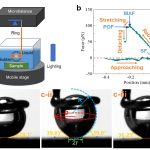In a new paper entitled “Nano-scaled roughness effect on air bubble-hydrophilic surface adhesive strength” and published in Colloids and Surfaces A: Physicochemical and Engineering Aspects, we describe the effect of nano-scaled roughness on adhesion of air bubble with hematite and pyrite. This is the result of our collaborative project with Northeastern University in China, and effort of two Chinese scholars, Zhanglei Zhu and Donghui Wang.
Surface roughness of solid affects its interactions with gas bubbles in water. Here, we investigate the effect of surface nano-scaled (random) roughness, quantified with the root-mean-square (RMS) roughness from about 3 to 260 nm, on the adhesive strength of air bubble with natural hydrophilic hematite and pyrite surfaces using a microelectronic balance-camera system. The recorded values include bubble-mineral adhesion forces, water contact angles, and bubble base diameters during stages of air bubble attachment and spreading, maximum adhesion, and detachment. The results confirm weakening of adhesive forces for air bubble with hydrophilic surfaces of increasing nano-scale roughness. The study reveals a linear dependency between adhesion force and RMS roughness. The adhesion force was also found to be in a linear correlation with contact angle and its sine function, providing evidence for the surface tension force dominance in adhesion of bubble to hydrophilic surface with nano-scaled surface roughness characteristics of random nature.
Bubble Adhesion with Nano-rough Surface
This entry was posted in Publications. Bookmark the permalink.

